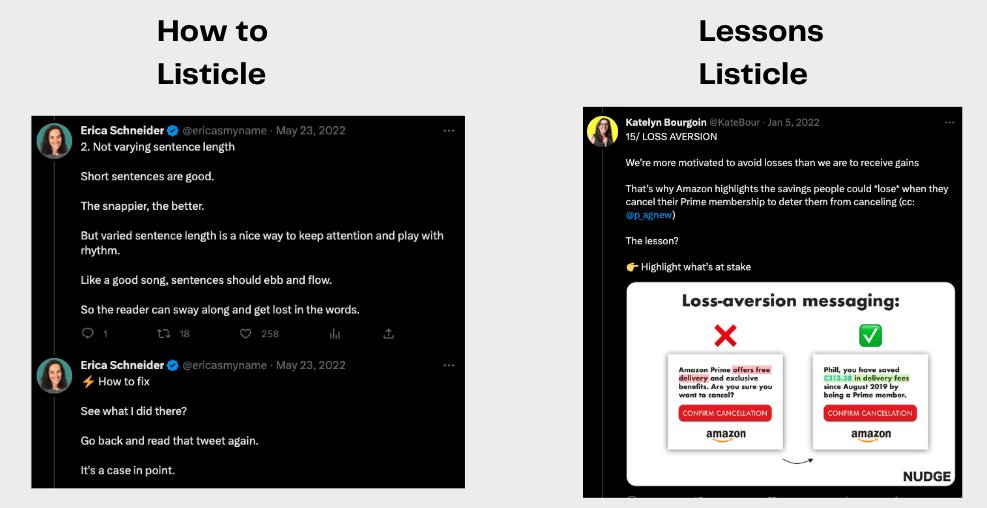1. Write an attention-grabbing hook
2. Prioritize structure
3. Make it about your audience
4. Deliver on your promises
Let's get specific ↓
1. Write an attention-grabbing hook
People want to know:
-Why should I read this?
-How will it help me?
-What will I learn?
To answer those Qs:
-Poke at pain points to light up emotions
-Add credibility to build trust
-Build intrigue to pique interest
-Leave a cliffhanger
There's a difference between shitty and valuable hooks.
Shitty hooks are regurgitated and soulless.
Or, they're clickbait (designed to capture attention but have zero value).
Here's how to write valuable & differentiated hooks instead:
https://t.co/xFus07265S
2. Prioritize structure
The best writing, presented in the wrong order, won't move the needle.
Your narrative arc needs to match your format, e.g.:
-Storytelling
-Listicles
-How to
Here's a snapshot of a "How to" vs. a "Lessons" listicle:
cc
@KateBour
Beyond the content format as a whole, you also need to strategically structure your hooks/individual tweets/paragraphs.
There are several formulas and frameworks out there.
Here's the one I use most often:
SCQA ↓
1. Situation (summary)
2. Complication (problem)
3. Question (transition)
4. Answer (solution)
E.g.
-Clickbait posts attract followers
-But disinterested audiences rarely buy
-The key to valuable growth that converts?
-Content that resonates & builds authority
The above example could work as a hook or in the body part of your post.
Here's my favorite example of this format in a hook:
cc:
@amandanat
3. Make it about your audience
People want to learn, grow, overcome problems, & reach goals.
You can talk about yourself but in the context of helping others.
Posts that are specific, direct, and outcome-driven perform much better than generalized, self-serving shares.
E.g.↓
Self-centered:
"My business is killing it. I've created amazing processes. Here's my story."
Audience-centered:
"I've built my business to $X MRR in 2 years. How? Documented processes from day 1 so I could delegate & focus on sales. Here are 7 lessons to scale efficiently."
The 2nd example does these things well:
-Adds quantifiable proof ($X MRR in 2 years)
-Gets specific with outcomes (delegate to save time + focus on sales)
-Tells the reader exactly what they'll learn (scale efficiently)
This builds trust and intrigue, which leads to clicks.
4. Deliver on your promises
You want readers to:
-Feel like they're learning
-Experience zero friction
-Stay interested throughout
To do that:
-Share unique insights
-Add the "why" and "how"
-Show, don't just tell
This helps them...
-Visualize the concepts you’re explaining
-Extract takeaways they can act on
-Reach “aha!” moments
-Get past objections
-Stay entertained
Consider:
-Why does this matter to my audience?
-How can the reader act on this?
-Can I back this up with data?
-What's the impact of this?
All of this said, writing advice means nothing if you don't:
-Know who you are
-Know who your audience is
This is not a one-and-done exercise.
Both you and your audience will continuously evolve.
Pay attention to those changes and shift your strategy accordingly.
I hope this helps you create more impactful social posts!
Follow me
@ericasmyname for more.
And comment and retweet as you please :)
For easy sharing:
https://t.co/2hATQoGeU9

